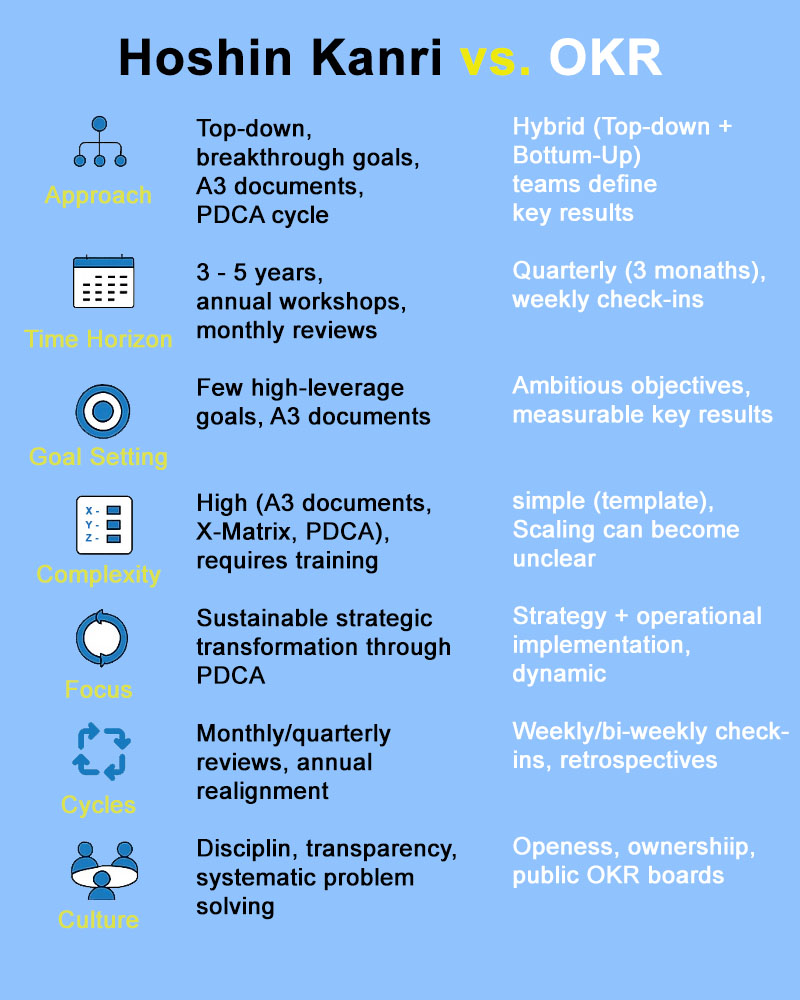Hoshin Kanri vs. OKR – a comparison
Between long-term vision and short-term implementation, companies navigate the tension between strategy and practice on a daily basis. Hoshin Kanri and OKR are two proven approaches for clearly defining goals, making progress measurable and embedding strategies in everyday work in a sustainable way.
After a brief look at their historical roots, I present seven key aspects for comparison: from approach and time horizon to goal setting, complexity and focus on strategy or implementation, to review cycles and corporate culture. Finally, I briefly explain the specific methods and tools used in Hoshin Kanri and give an outlook on how both frameworks can be successfully combined in everyday life.
Let’s get started!
A brief look at the origins of Hoshin Kanri and OKR
Hoshin Kanri, which roughly translates as ‘compass needle management’, was developed at Toyota in the 1960s. The aim was to derive a few clearly defined breakthrough goals from a general corporate vision and to systematically control profound improvements rather than leaving them to chance. In Japan, this approach became known as policy deployment, a structured process that emphasised the early involvement of all levels of the hierarchy. From the executive suite to the shop floor, everyone should understand how they can contribute to achieving the big goals. [1]
OKR, short for Objectives and Key Results, emerged just over a decade later in the late 1970s at Intel. Andy Grove, the CEO at the time, was looking for a flexible framework to make ambitious goals tangible and measurable without getting bogged down in rigid strategy papers.
Investor John Doerr brought the concept to Google in the 1990s. There, OKRs helped to align a rapidly growing organisation, sharpen its focus and create transparency. To this day, the framework is considered one of the cornerstones of Silicon Valley’s culture of innovation. [2]
1. Approach
Hoshin Kanri primarily follows a clear top-down principle. The top management sets a handful of breakthrough goals to be achieved within three to five years. These major goals are then broken down step by step: from the business unit to the department to the individual team. At each level, so-called A3 documents are created in which the cause of the problem, the target state, measures and results are clearly recorded. At the same time, all measures continuously go through the PDCA cycle (Plan-Do-Check-Act) in order to review progress, learn from experience and make adjustments as required. [3]
OKR, on the other hand, combines top-down targets with bottom-up contributions. The strategic objectives are set by senior management, while teams and employees develop their own key results independently. This hybrid approach promotes motivation and ownership, as everyone leaves their own mark on the goals.
2. Time horizon
A characteristic feature of Hoshin Kanri is its long-term perspective: breakthrough goals span three to five years and are accompanied by annual strategy workshops in which the plan is reviewed and adjusted. Within a year, there is a kick-off round in which operational sub-goals are defined for the quarters, and there are monthly to quarterly management reviews.
OKR, by contrast, are designed for short cycles: teams typically work in quarters, i.e. three months at a time, and review their progress weekly or every two weeks. This short interval increases responsiveness to market changes, but requires a stable framework to ensure that the long-term vision is not lost.
3. Goal setting
Two key questions in Hoshin Kanri are:
- ‘Where do we really want to achieve a breakthrough as a company?’
- ‘Which few goals have the greatest leverage?’
These breakthrough goals are formulated extremely concisely and linked to precise metrics. Each A3 sheet then documents how the team intends to get from the current situation to the target state.
OKR focus on ambitious but achievable objectives, supported by concrete, measurable key results. An objective could be ‘achieve market leadership in segment X,’ while the key results define measurable metrics such as sales, customer ratings or feature completions. This creates a clear framework for action for everyone involved.
4. Complexity in application
The comprehensive implementation of Hoshin Kanri requires discipline and training: the multi-stage derivation, creation and maintenance of A3 reports, regular PDCA reviews and the use of an X-matrix for consolidated visualisation are time-consuming. An X-matrix summarises strategic goals, key figures, key measures, responsible persons and schedules in a single document and facilitates coordination between levels.
OKR are relatively quick to implement: a simple template with one objective and three to five key results is all you need to get started. However, in fast-growing or large organisations, maintaining hundreds of OKRs can become confusing if clear responsibilities and review routines are not established.
5. Focus on strategy vs. implementation
Hoshin Kanri is deeply rooted in strategy: it translates vision and mission into structured packages of measures that are rolled out at all levels. The focus is on sustainable transformation, which is ensured by continuous PDCA loops.
OKR, on the other hand, dynamically links strategy and implementation: objectives set the strategic direction, while key results define the operational milestones. Regular check-ins promote real-time learning and enable quick course corrections.
Both approaches can be combined: Hoshin provides the long-term roadmap, while OKR enlivens short-term implementation with agility.
6. Review cycles
An integral part of Hoshin Kanri are the PDCA cycles at every level: Plan (define goals & measures), Do (implement measures), Check (measure results) and Act (make adjustments). Monthly or quarterly management reviews ensure that deviations are recognised in good time. Annual kick-off meetings allow for the realignment of breakthrough goals.
OKR involves standardised check-in meetings, usually weekly or biweekly, where teams present their progress on key results. At the end of the quarter, a retrospective is held to incorporate insights into the next planning cycle. [4]
7. Corporate culture
Hoshin Kanri requires discipline, transparency and a culture that values systematic problem solving. The A3 workshops promote joint learning: teams identify weaknesses, question assumptions and document their solutions. The X-Matrix makes it possible to recognise links across departmental boundaries and exploit synergies.
OKRs establish a culture of openness and personal responsibility: public OKR boards allow employees to see what others are working on and provide support or input when demand arises. Mistakes are not penalised, but rather seen as a source of improvement.
Both approaches therefore contribute to a learning organisation.

Table: Hoshin Kanri and OKR in comparison
Methods and tools in Hoshin Kanri
Hoshin Kanri uses three central methods or tools:
- PDCA (Plan-Do-Check-Act): The iterative improvement cycle is at the heart of systematically verifying and adjusting plans.
- A3 management: A DIN A3 form serves as a compact communication and problem-solving document. It structures problem definition, cause analysis, action plans and results presentation on a single page and also serves as a basis for communication with those involved and at the decision-making level.
- X-Matrix: As a Western development, it summarises strategic goals, key figures, measures, responsible persons and schedules in a single graphic. The matrix simplifies coordination across multiple levels and ensures transparency.
These tools make the Hoshin Kanri process rigorous, transparent and effective – in line with the lean philosophy, which avoids waste and focuses on value-adding activities.
Final thoughts
Hoshin Kanri and OKR are not contradictory, but rather complement each other well. Hoshin Kanri provides a stable framework for long-term, far-reaching change and ensures commitment with clear methods and tools. OKR brings agility, transparency and participation into play, motivates employees and enables quick adjustments.
Together, both approaches give companies the opportunity to translate their visions into clear strategies while remaining flexible enough to respond to changes in the market. This fosters a culture that combines systematic process optimisation with dynamic learning and involves all levels in goal setting. This is precisely what is crucial for lasting success, even in complex times.
Notes:
Please feel free to contact Goetz Mueller if you would like to discuss Hoshin Kanri, OKR or the combination of both approaches in your company. And if you want to use one or both approaches in your company, he is definitely the right person to talk to. You can easily reach Goetz Mueller on LinkedIn or via his website.
[1] Here you can find a podcast episode on the topic in German: Hoshin Kanri: Management of goals and plans.
[2] Here you can find more information on Objectives and Key Results.
[3] Here you can find more information on the PDCA cycle.
[4] And here you can find more information on retrospectives.
If you like this article or want to discuss it, please share it in your network. And if you have any comments, please do not hesitate to send us a message.
Goetz Mueller has published more articles on the t2informatik Blog, including:

Götz Müller
Goetz Mueller has been involved in the management of development projects since 1993, change projects and continuous improvement processes since 1998 and Neuro-Linguistic Programming since 2006. He is a trained Lean Facilitator, Lean Six Sigma Black Belt and NLP Master Practitioner. Since 2009, he has been working as an independent consultant, trainer and coach, supporting small businesses, SMEs, craft businesses and corporate sites in matters of process optimisation and the continuous improvement process.
In the t2informatik Blog, we publish articles for people in organisations. For these people, we develop and modernise software. Pragmatic. ✔️ Personal. ✔️ Professional. ✔️ Click here to find out more.


